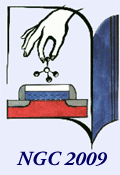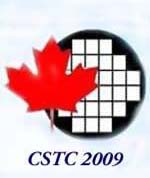
|
Nano and Giga Challenges in Electronics, Photonics and Renewable Energy | 14th Canadian Semiconductor Technology Conference |

 |
|
 |
|
|
Commentary
First was the word, actually two - "nano" and "giga". They came out our discussions with co-chairman of the first meeting Andreas Wild, who was the Motorola division manager in Germany. If I remember it right, it was in October 2001 in Munich, slightly less that a year before the first NGC meeting in Moscow. The idea of an extended review of Motorola's projects in Moscow had quickly grown up to a full scale international conference on nanoelectronics. NGCM2002 meeting was enthusiastically supported by two Motorola branches, SPS (Semiconductor Products Sector, now Free Scale Semiconductor) in Phienix and in Austin and Motorola Moscow office. The title of the first two meetings included the word "microelectronics" since at that time "nanoelectronics" was not yet a popular and recognized term, as it is now. NGCM2002 meeting was attended by more than 400 participants (about more than 100 from abroad), half of them from Moscow. In large extent success of the first conference was due to the great help of Kintech, research and consulting company at Kurchatov Institute, Motorola contractor on several projects in computational materials and process design. Several key traditions have been established at the first conference in Moscow, such as make up of the scientific program from two parts, school (tutorial lectures) and symposium with most of the oral presentations given by the world class scientific leaders. Meanwhile, all Nano and Giga Forums traditionally have large number of "young talents", students, postdocs and early career professors and researchers. Very active informal networking atmosphere fueled by diversified social program is another tradition of our series of meetings. After each meeting we publish a tutorial book and two special journal issues comprised by selected papers. Our conference papers have been published in high rank international journals and have been peer reviewed at the same level as the regular papers in the host journals, as different from typical conferences proceedings known as "dust collectors". Our second conference, NGCM2004, was held in the old beautiful Polish city Krakow, hosted by Jagiellonian University and co-organized by FQS Poland, research and software company in the area of computational chemistry. While our second meeting, no longer associated with large electronic company (Motorola), has been less attended in the total numbers of participants (about 300), it had grown to larger international participation. Scientists from 40 countries attended NGCM2004 vs attendees from 24 countries at NGCM2002. Our third meeting,NGC2007was held in Tempe, Arizona and hosted by Arizona State University. Note that the conference acronym of the 3rd meeting was abbreviated to "NGC" and "microelectronics" was replaced in the title by "electronics and photonics" to reflect the equal importance of two major parts of the meeting's program, the science and technology based on electrons and photons, respectively, the two "work horses" of information processing and storage devices. A new tradition has been added to the conference series at the 3rd conference - technology interface sessions - a forum designated to bridge science, technology, business and society. By its very nature, our meetings are open for new "experiments" in conference management and meeting organization. Our next forum, NGC2009, in Hamilton, Ontario, Canada, hosted by McMaster University, will become a joint meeting with 14th Canadian Semiconductor Conference - CSTC2009. While Nano & Giga Forums have certain character of "elite" type meetings by having most of the oral papers given by internationally renown scientists, world recognized leaders in their research field, the CSTC conferences traditionally have been forums for early career scientists provided by opportunities to present oral talks in front of the audience comprised by other young colleagues, review panel of local Canadian "gurus" and a few international "celebrities'. To blend together traditions of these two meetings, the organizers of the joint NGC/CSTC meeting have introduced, so called discovery workshop, the oral sessions comprised by contributed papers. The technology sessions at the NGC/CSTC meeting in Canada have been entitled [Innovations at the Edges workshop] (14) in order to outline the focus of this forum on new technologies and to attract innovators, industry leaders and investors to the meeting, where technical and business due diligence can be done at the spot. The last but certainly not the least new addition to the Nano & Giga Forum at its 4th meeting is introduction renewable energy to the conference topics. Importance of alternative energy for our modern society can hardly be overestimated. At the same time, photovoltaic devices, converters of solar energy in electricity are made of silicon and other semiconductors, which have been researched and explored for decades in electronics and optoelectronics/photonics. While solar energy research in the past was deprived of funding due to the cheap price of mineral oil and gas, electronics thrived at the Golden Era of Moore's Law (last 30+ years). Nowadays the situation is becoming reverse - alternative energy research and technology development gets more funding than information technology. At the same time nanoelectronics research centers at the Universities, governmental and industrial R & D labs have collected invaluable expertise and expensive equipment, which can be applied easily in the new field of applications - solar energy. Transfer of expertise from nanoelectronics and photonics to solar energy research is one of the crucial missions of our next forum in Canada. Acknowledgement Special thanks to my dear friends, Dr. Jan Labanowski and Maria Oseeva, for their help to the Nano & Giga Forum and to all sponsors, friends, colleagues and participants of NGC meetings for their support, contributions, ideas and encouragement. |